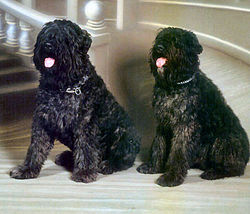
The Swedish Vallhund, also known as the Västgötaspets and Swedish cow dog, is a breed of dog native to Sweden. The breed's name, Vallhund, when translated into English, means herding dog, as the Swedish Vallhund was originally bred as a drover and herder of cows over 1,000 years ago. In 1942, the dog came close to extinction, but careful breeding and publicity by Swedish national Björn von Rosen and K. G. Zettersten managed to revive the breed in popularity and save it from its likely end. In 1943, the Swedish Kennel Club recognized the Swedish Vallhund as a breed, and officially categorized the Swedish Vallhund as "the Västgötaspets" for Västergötland, the province in which their revival took place. Since then, the breed has been recognized by, and bred in, over ten countries and has gained some popularity.

The Welsh Corgi is a small type of herding dog that originated in Wales. The name corgi is derived from the Welsh words cor and ci, meaning "dwarf" and "dog", respectively.

The Boxer is a medium to large, short-haired dog breed of mastiff-type, developed in Germany. The coat is smooth and tight-fitting; colors are fawn, brindled, or white, with or without white markings. Boxers are brachycephalic, have a square muzzle, mandibular prognathism, very strong jaws, and a powerful bite ideal for hanging on to large prey. The Boxer was bred from the Old English Bulldog and the now extinct Bullenbeisser, which became extinct by crossbreeding rather than by a decadence of the breed. The Boxer is a member of both The Kennel Club and American Kennel Club (AKC) Working Group.

The Australian Cattle Dog, or simply Cattle Dog, is a breed of herding dog developed in Australia for droving cattle over long distances across rough terrain. This breed is a medium-sized, short-coated dog that occurs in two main colour forms. It has either red or black hair distributed fairly evenly through a white coat, which gives the appearance of a "red" or "blue" dog.

Collies form a distinctive type of herding dogs, including many related landraces and standardized breeds. The type originated in Scotland and Northern England. Collies are medium-sized, fairly lightly-built dogs, with pointed snouts. Many types have a distinctive white color over the shoulders. Collies are very active and agile, and most types of collies have a very strong herding instinct. Collie breeds have spread through many parts of the world, and have diversified into many varieties, sometimes mixed with other dog types.
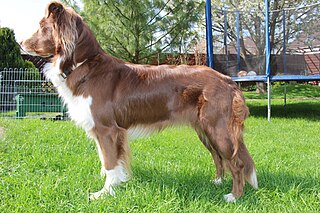
The Australian Shepherd is a breed of herding dog from the United States. The name of the breed is technically a misnomer, as it was developed in California in the 19th century. It is believe to have its origins in sheepdog breeds from northwest Spain, as well as collies imported, alongside sheep, from Australia and New Zealand; the breed reportedly took its name from this trade. Originally used solely as a herding dog, the Australian Shepherd has become one of the most popular companion dog breeds in North America.

The Cardigan Welsh corgi is one of two different varieties of livestock-herding dog breeds known as Welsh corgis, with the other being the Pembroke Welsh corgi. It is one of the oldest breeds of the British Isles. Cardigan Welsh corgis are known to be an extremely loyal and trainable dog breed, naturally attuned to herding many different animals, from poultry and waterfowl to large livestock such as sheep and cattle. They are also versatile and can live in a variety of settings.

The Pembroke Welsh Corgi is a cattle herding dog breed that originated in Pembrokeshire, Wales. It is one of two breeds known as a Welsh Corgi, the other being the Cardigan Welsh Corgi. Pembroke Welsh Corgis descended from the Spitz family of dogs.

The Entlebucher Sennenhund or Entlebucher Mountain Dog is a medium-sized herding dog, it is the smallest of the four regional breeds that constitute the Sennenhund dog type. The name Sennenhund refers to people called Senn, herders in the Swiss Alps. Entlebuch is a region in the canton of Lucerne in Switzerland. The breed is also known in English as the Entelbuch Mountain Dog, Entelbucher Cattle Dog, and similar combinations.

The Belgian Shepherd, also known as the Belgian Sheepdog or the Chien de Berger Belge, is a Belgian breed of herding dog of medium size. It is bred in four distinct varieties based on coat type and colour: the long-haired black Groenendael; the rough-haired fawn Laekenois; the short-haired fawn Malinois, and the long-haired fawn Tervuren. The American Kennel Club considers the four varieties to be separate breeds.
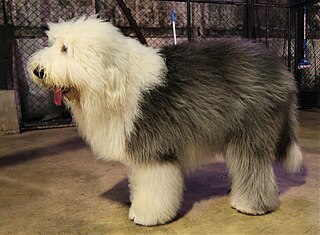
The Old English Sheepdog is a large breed of dog that emerged in England from early types of herding dog. Obsolete names for the breed include Shepherd's Dog and bob-tailed sheep-dog. The nickname Bob-tail originates from how dogs of the breed traditionally had their tails docked. Old English Sheepdogs can grow very long coats with fur covering the face and eyes and do not shed unless brushed.
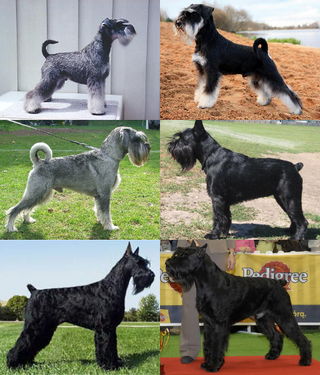
A Schnauzer is a dog breed type that originated in Germany from the 14th to 16th centuries. The term comes from the German word for "snout" and means colloquially "moustache", or "whiskered snout", because of the dog's distinctively bearded snout. Initially it was called Wire-Haired Pinscher, while Schnauzer was adopted in 1879.

The Miniature Pinscher, also known as the Zwergpinscher and Mini Pin, is a small breed of dog of the pinscher type originating in Germany. While the breed's visual similarities to the Toy Manchester Terrier, which somewhat resembles the Pinscher breeds, remain a matter of controversy, genetic research has shown that the two breeds have shared, unique ancestry. The ancestors of the Toy Manchester and Miniature Pinscher may have become geographically separated many centuries ago and retained similarities simply through breeding selection for the same traits; nevertheless, the 2017 research also showed that the two breeds remain more closely related to each other than to other breeds. The breed's ancestors may also include the German Pinscher, Italian greyhounds and dachshunds. The Miniature Pinscher's known origins are in Germany, where it was often referred to as the Zwerg Pinscher in historical documents. German Kennel Club documents also refer to the Miniature Pinscher as the "reh" Pinscher, but this term is only used for a dog of stag-red color, "reh" referring to a small red deer formerly found in German forests. The Miniature Pinscher originated several centuries ago as an efficient barnyard ratter.

The Giant Schnauzer is a breed of dog developed in the 17th century in Germany. It is the largest of the three breeds of Schnauzer—the other two breeds being the Standard Schnauzer and the Miniature Schnauzer. Numerous breeds were used in its development, including the black Great Dane, the Bouvier des Flandres, and the German Pinscher. Originally bred to assist on farms by driving livestock to market and guarding the farmer's property, the breed eventually moved into the city, where it worked guarding breweries, butchers' shops, stockyards and factories. It was unknown outside of Bavaria until it became popular as a military dog during World War I and World War II.

The Dutch Shepherd is a herding dog of Dutch origin. They were used by shepherds and farmers who needed a versatile dog, with few demands, and a dog that was able to adapt to a harsh and meager existence.
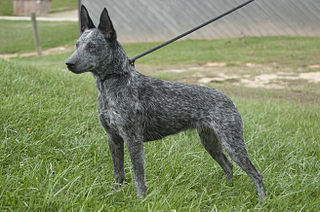
The Australian Stumpy Tail Cattle Dog, commonly known as the Stumpy, is a naturally bobtailed or tailless medium-sized cattle dog closely related to the Australian Cattle Dog. The Australian Stumpy Tail Cattle Dog and the Australian Cattle Dog share Halls Heeler origin.

The Portuguese Sheepdog is a medium-sized breed of dog of the herding dog type, and is one of the indigenous regional dogs of Portugal. The Portuguese name refers to Serra de Aires, a mountain near Montforte in the Alentejo region. The breed is nicknamed cão macaco for its furry face and lively attitude.
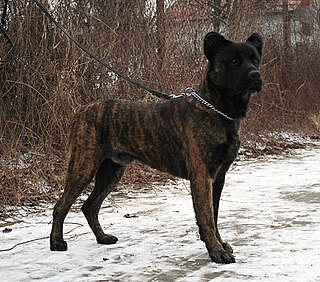
The Saint Miguel Cattle Dog is a dog breed of mastiff type originating on São Miguel Island in the Azores, an island chain which is one of the autonomous regions of Portugal. The breed was originally used as a herding dog for working with cattle.

Bouvier des Ardennes is a rare dog breed from Belgium. Originating in the Ardennes region these dogs were used to herd cattle. The loss of farms in the area led to serious decline in the numbers of these dogs until 1985 when some breeders found a few dogs and used the original breed standard as their guide in re-introducing the dog.
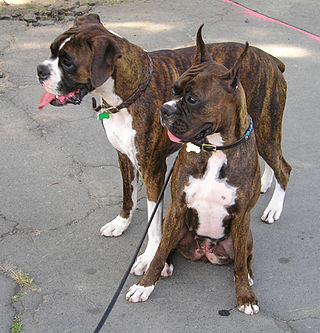
Cropping is the removal of part or all of the external flaps of an animal's ear. The procedure sometimes involves bracing and taping the remainder of the ears to train them to point upright. Almost exclusively performed on dogs, it is an old practice that was once done for perceived health, practical or cosmetic reasons. Veterinary science states there is no medical or physical advantage to the animal from the procedure, leading to concerns of animal cruelty over performing unnecessary surgery on animals. In modern times, cropping is banned in many nations, but is still legal in a limited number of countries. Where permitted, it is seen only in certain breeds of dog, such as pit bull and bull terrier type breeds, the Doberman Pinscher, Schnauzer, Great Dane, Boxer and Cane Corso.



